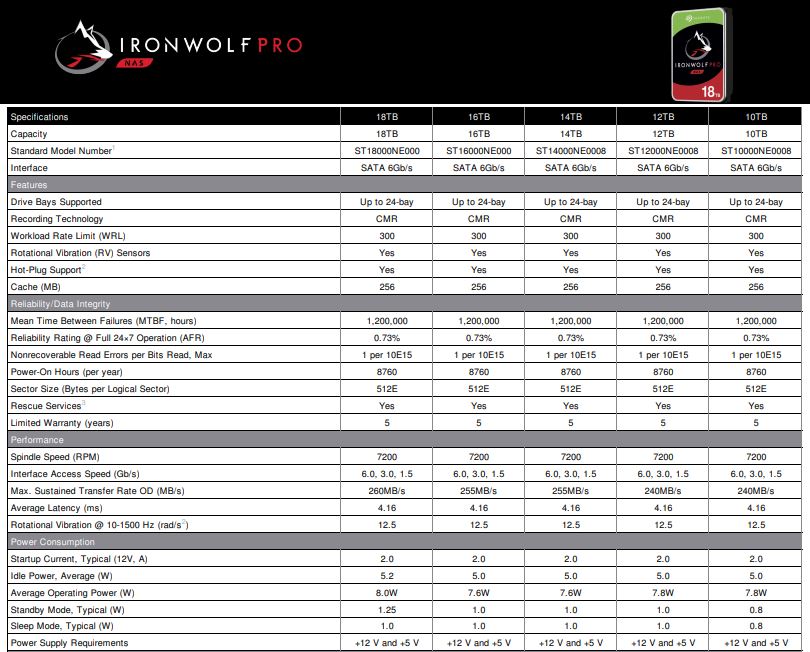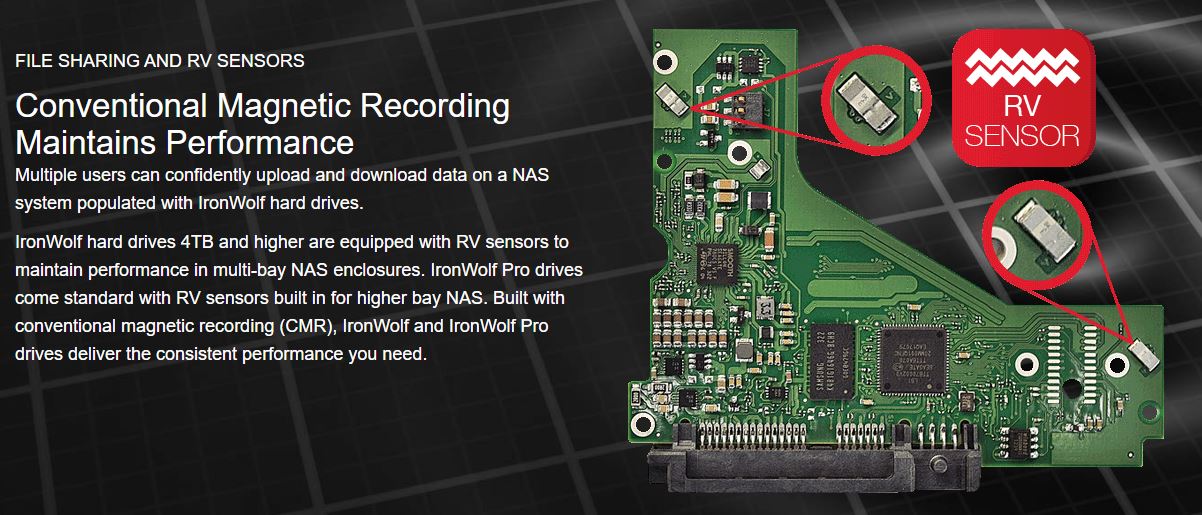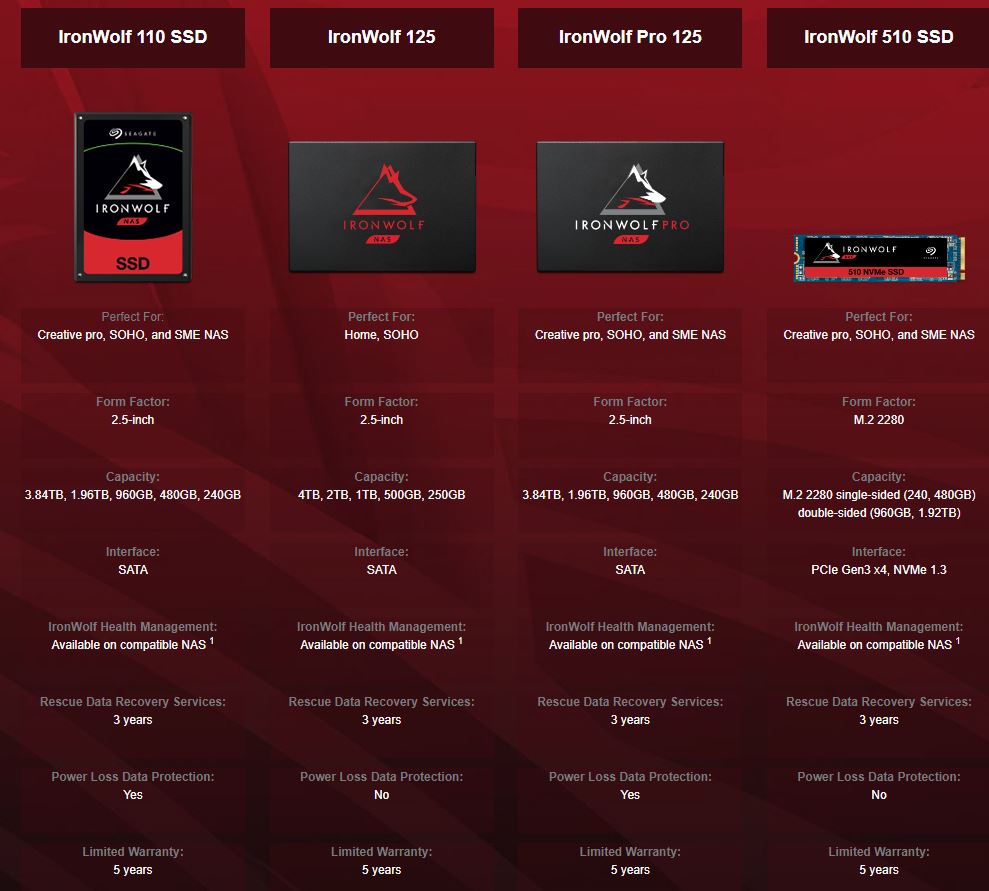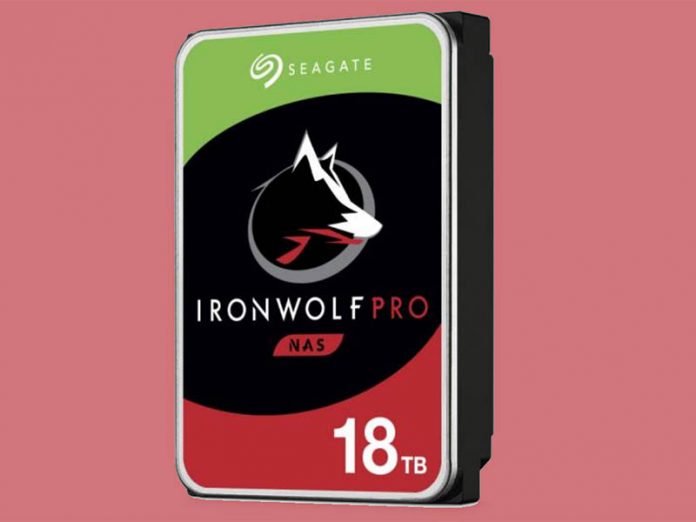This week, Seagate announced a new set of higher-capacity IronWolf drives. The new drives include a new 18TB IronWolf Pro NAS hard drive and both IronWolf Pro 125 and IronWolf 125 SATA SSDs that scale into the 4TB capacity class.
Seagate IronWolf Pro 18TB HDD
The Seagate IronWolf Pro 18TB hard drive is designed for NAS units up to 24 drive bays. This compares to the standard IronWolf line that is more for the 1-8 drive segment. These drives have rotational vibration sensors to help manage the drives in larger arrays where there can be more chassis vibration than in smaller arrays.

The new drives offer more capacity with the faster “Pro” 7200 RPM spindle speed. Pricing is around $609 which means there is a steep premium for the 18TB models. Even the Seagate Exos 16TB drives are selling for under $400 and the IronWolf/ Pro 16TB drives are in the $460-510 range. That puts the new IronWolf Pro 18TB at a >6% premium for the higher capacity on a cost per TB basis versus the 16TB model.

At STH, we pushed hard on the SMR v. CMR topic you may have read in Surreptitiously Swapping SMR into Hard Drive Lines Must Stop. After we tested WD Red SMR vs CMR and found SMR is very bad. WD is still marketing their WD Red SMR drives, so this is important and great that Seagate uses CMR. If you want to learn more, here is a video on our testing the SMR drives in a common ZFS NAS platform:
It is great to see Seagate take this seriously and heavily feature CMR on their spec sheets and marketing materials for the IronWolf Pro. In theory, SMR was designed to increase drive capacities at the top-end not the lower-end of the spectrum where we found it.
4TB-class Seagate IronWolf (Pro) 125 SSDs
Seagate has new IronWolf Pro 125 and IronWolf 125 SATA SSDs NAS-optimized drives. These drives are able to reach into the 4TB capacity range. Seagate is doing a bit of juggling and bifurcating the SSD realm into lower-performance and higher performance SSDs. Here is a great illustration of the new Seagate IronWolf 125 4TB versus the previous-gen Seagate IronWolf 110 3.84TB SATA SSD.

As you can see, one gets lower spare area on the drive to boost capacity up to 4TB with the IronWolf 125, but endurance suffers with 1.4PBW less (still 0.7DWPD) and a 10% lower MTBF (1.8M hours v. 2M hours.) Seagate did a bit of a shift, and now we have the ZA3840NX10001 IronWolf Pro 125 SSD with specs more comparable to the IronWolf 110 model.

This seems to be confirmed by the Seagate SSD comparison chart as well. On the chart, the biggest thing separating the IronWolf 125 Pro and 110 drives is the IronWolf 125 (non-Pro) placed in the middle.

At STH, we looked at the Seagate IronWolf 110 480GB SATA NAS SSD, and more recently the Synology SAT5200-960G and WD Red SA500 1TB SSD. The Synology drive seems to be considerably overbuilt as a 2.5″ offering and the WD Red SA500 is offering a very lightweight feature set, but also a M.2 form factor.
Final Words
Higher capacity drives can help lower the overall system cost by using drive bays more efficiently. To much of the market, having a new, higher-capacity, drive means that lower capacity drives become less costly. This action previously happened at a higher rate when competition and innovation in the hard drive space led to rapid and meaningful capacity increases. Still, larger drives are always welcome, especially when they are CMR for this market which Seagate continues to use. Overall, The Seagate IronWolf Pro 18TB is a small incremental step of advancement in the space, but we need such advancement in the industry.





Funny when you look at the “workload rate limit” of spinning drives. This 18TB will only give you 0.046DWPD if you do writes only (the workload rate limit also includes reads). Nearline SAS drives are not a lot better (WRL=~500).
I’m wondering how much the price would go down if SSD’s were at <0.05DWPD.
The Seagate Web site states that the IronWolf Pro125 SSD series includes PLDP circuitry (Power Loss Data Protection). Obviously the web site states that a UPS is not enough.
This sounds to me like the optional battery module you can install on a RAID card.
However if the host is aware of the power loss message from the UPS, the host has the time to shutdown and therefore issues the sync to all disks. I find the argumentation of Seagate in this case to be reaching.
The PLDP circuitry might be useful though in case of a spurious reboot (Kernel Panic or Windows BSOD).
What do you think?
domih,
Are you sure your hardware removes power on reset?
A write from your OS may have been trying to only rewrite 512 bytes or 4k thinking its a sector, which most flash drives cannot do. Assuming the drive is in a state of needing to reuse a sector, they read a larger chunk, erase it, and write the whole larger chunk with old data+new data. Wear leveling usually means it won’t be rewriting the same block directly, but then the table of blocks is something the drive has to internally note down (a possible write of data). If power goes out, any areas of memory being rewritten stand a chance of corruption resulting in damage to whatever was represented there.
Battery backups with orderly shutdowns are good to have, but can you rely on batteries being replaced on time, batteries not being defective, AC cable not becoming unplugged, hard drive not becoming unplugged, power supply in computer not failing, etc.? SATA cables may now often have retaining clips, but they are still bad connectors that when I was first introduced to I found took tricks to make sure connector had positive pressure on them so a cable couldn’t fall out or use chemistry to lock in place.
I think a drive without power loss protection circuitry is just the manufacturer choosing to sell a storage device with known faults that can cause it to be unnecessarily unreliable.